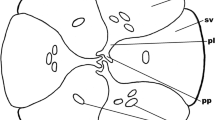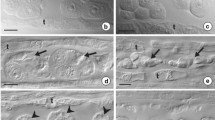Abstract
Embryological characters ofLindmania penduliflora is presented. Anther tapetum is of the secretive type and the cells are binucleate. Microspore mother cells divide in a successive manner resulting in isobilateral, tetrahedral or linear tetrads. Mature pollen grain is two-nucleate. Division of the single hypodermal archesporial cell results in a primary parietal cell and a megaspore mother cell. Meiotic division of the latter results in a linear tetrad. The chalazal megaspore of the tetrad develops into a normal type of eight-nucleate embryo-sac.
Endosperm is of the helobial type. The chalazal endosperm nucleus may divide, with or without wall formation, either synchronised with the division of the micropylar endosperm nucleus or else earlier.
Zusammenfassung
Die embryologischen Merkmale vonLindmania penduliflora werden beschrieben. Die Antheren weisen eine Sekretions-Tapete auf mit zwei kernigen Zellen. Die Mikrosporen-Mutterzellen teilen sich sukzessiv, wobei isobilaterale, tetraedrische oder lineare Tetraden entstehen. Die reifen Pollen sind zweikerning.
Durch Teilung einer einzigen hypodermalen Archespor-Zelle entstehen eine primäre Scheitelzelle und eine Megasporen-Mutterzelle. Die meiotische Teilung der letzeteren ergibt eine lineare Tetrade. Die chalazale Megaspore entwickelt sich zu einem normalen 8-kernigen Embryosack.
Die Endospermbildung entspricht dem Helobiaceen-Typus. Der chalazale Endosperm-Kern teilt sich mit oder ohne Wandbildung und gleichzeitig mit der Teilung des mikropylaren Endosperm-Kerns oder früher.
Embryological literature on the family Bromeliaceae is neither very plentiful nor detailed enough to allow thorough discussion. Since the treatise of Schnarf (1931) two more papers have been published. The report of Beck and Horton (1932) deals mainly with the cytology and adds a few embryological data on some species ofBromus. The work of Guttenberg and Riebe (1957) pertains to embryogeny of certain species ofPitcairnia. Since the available data are either contrary to each other or incomplete, the embryological investigation of the family will here be taken up: the present contribution is the first of a series.
Lindmania penduliflora, native of Peru, was in flowering during the month of April in the Botanical Gardens of the Freie Universität, Berlin-Dahlem. Material was collected in May 1965 and fixed in FPA (Formalin-Propionic. Acid-Alcohol). The slides were prepared following the customary microtechnical methods using haematoxylin stain.
Similar content being viewed by others
References
Beck, B. and Horton, J. S... “Microsporogenesis and embryogeny in certain species ofBromus,”Bot. Gaz., 1932,93, 42–54.
Brenner, W... “Zur Kenntnis der Blütenentwicklung einiger Juncaceen,”Acta Soc. Sci. Fenni, 1922,10, 1–37.
Guttenberg, H. von und Riebe, I. “Die Entwicklung des Embryos und der Keimpflanze von Bromeliaceen,”Bot. Studien (Jena), 1957,7, 142–57.
Hamann, U... “Merkmalsbestand und Verwandtschafts-beziehungen der Farinosae,”Willdenowia (Berlin), 1961,2, 639–768.
—————.. “Über Bau und Entwicklung des Endosperms der Philydraceae und über die Begriffe “mehliges Nährgewebe” und Farinosae,”Bot. Jb., 1962,81, 397–407.
—————.. “Die Embryologie vonPhilydrium lanuginosum (Monocotyledoneae-Philydraceae),”Ber. dtsch. bot. Ges., 1963,76, 203–08.
—————.. “Embryologie und Systematik am Beispiel der Farinosae,” Ibid., 1964,77, 45–54.
—————.. “Embryologische, morphologisch-anatomische und systematische untersuchungen an Philydraceen”Willdenowia (Berlin), 1966,4, 1–178.
Kapil, R. N. and Karvita Walia “The embryology ofPhilydrum lanuginosum Banks, ex Gaertn. and the systematic position of the Philydraceae,”Beitr. Biol. Pfl., 1965,41, 381–404.
Lakshmanan, K. K... “Embryological studies in the Hydrocharitaceae. III.Nechamandra alternifolia,”Pyton., 1963,20, 49–58.
Schnarf, K. ..Vergleichende Embroyologie der Angiospermen, Berlin, 1931.
Swamy, B. G. L. and Parameswaran, N. “The helobial endosperm,”Biol. Rev., 1963,38, 1–50.
Wunderlich, R... “Zur Frage der Phylogenie der Endospermtypen bei den Angiospermen,”Öst. bot. Z., 1959,106, 203–93.
Author information
Authors and Affiliations
Additional information
Communicated by Prof. T. S. Sadasivan,f.a.sc.
Rights and permissions
About this article
Cite this article
Lakshmanan, K.K. Embryological studies in the bromeliaceae. Proc. Indian Acad. Sci. 65, 49–55 (1967). https://doi.org/10.1007/BF03052167
Received:
Issue Date:
DOI: https://doi.org/10.1007/BF03052167




